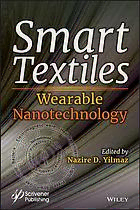
Smart textiles: wearable nanotechnology PDF
Preview Smart textiles: wearable nanotechnology
Smart Textiles Scrivener Publishing 100 Cummings Center, Suite 541J Beverly, MA 01915-6106 Publishers at Scrivener Martin Scrivener ([email protected]) Phillip Carmical ([email protected]) Smart Textiles Wearable Nanotechnology Edited by Nazire D. Yilmaz Thiseditionfirstpublished2018byJohnWiley & Sons,Inc.,IIIRiverStreet,Hoboken,NJ07030,USA and Scrivener Publishing LLC, 100 Cummings Center, Suite 541J, Beverly, MA 01915, USA © 2019 Scrivener Publishing LLC For more information about Scrivener publications please visit www.scrivenerpublishing.com. All rights reserved. No part of this publication may be reproduced, stored in a retrieval system, or transmitted, in any form or by any means, electronic, mechanical, photocopying, recording, or other- wise, except as permitted by law. Advice on how to obtain permission to reuse material from this title is available at http://www.wiley.com/go/permissions. Wiley Global Headquarters 111 River Street, Hoboken, NJ 07030, USA Fordetailsofourglobaleditorialoffices,customerservices,andmoreinformationaboutWiley prod-- ucts visit us at www.wiley.com. Limit of Liability/Disclaimer of Warranty Whilethe publisherandauthorshaveusedtheirbesteffortsinpreparingthiswork,theymakenorep- resentations or warranties with respect to the accuracy or completeness of the contents of this work and specificallydisclaimall warranties,includingwithoutlimitationanyimpliedwarrantiesofmerchan-t abilityorfitnessforaparticularpurpose.Nowarrantymaybecreatedorextendedbysalesrepresenta- tives,writtensalesmaterials, or promotionalstatementsforthiswork.Thefactthatanorganization, website, or product is referred to in this work as a citation and/or potential source of further informa- tion does not mean that the publisher and authors endorse the information or services the organiza- tion, website,orproductmayprovide orrecommendationsitmaymake.Thiswork issoldwiththe understandingthat thepublisherisnot engaged inrenderingprofessional services.Theadviceand sstrategies contained herein may not be suitable for your situation. You should consult with a specialist whereappropriate.Neitherthepublishernorauthorsshallbeliableforanylossofprofitoranyother commercial damages, including but not limited to special, incidental, consequential, or other damages. Further, readers should be aware that websites listed in this work may have changed or disappearedd bbeettwweeeenn wwhheenn tthhiiss wwoorrkk wwaass wwrriitttteenn aanndd wwhheenn itit isis rreeaadd.. Library of Congress Cataloging-in-Publication Data ISBN 978-1-119-46022-0 Cover image: Pixabay.Com CoverdesignbyRussell Richardson Set in size of 11pt and Minion Pro by Manila Typesetting Company, Makati, Philippines Printed in the USA 10 9 8 7 6 54 3 2 1 Contents Preface xv Acknowledgments xvii Section 1: Introduction 1 1 Introduction to Smart Nanotextiles 3 Nazire Deniz Yilmaz 1.1 Introduction 3 1.1.1 Application Areas of Smart Nanotextiles 7 1.1.2 Incorporating Smartness into Textiles 8 1.1.3 Properties of Smart Nanotextiles 9 1.1.4 Nanotechnology 9 1.1.5 Nanomaterials 10 1.2 Nanofibers 11 1.2.1 Moisture Management 12 1.2.2 Thermoregulation 13 1.2.3 Personal Protection 13 1.2.4 Biomedicine 14 1.3 Nanosols 14 1.3.1 Applications of Nanosols 15 1.4 Responsive Polymers 16 1.5 Nanowires 18 1.6 Nanogenerators 19 1.7 Nanocomposites 21 1.8 Nanocoating 23 1.9 Nanofiber Formation 24 1.10 Nanotechnology Characterization Methods 26 1.11 Challenges and Future Studies 27 1.12 Conclusion 29 References 29 v vi Contents Section 2: Materials for Smart Nanotextiles 39 2 Nanofibers for Smart Textiles 41 Lynn Yuqin Wan 2.1 Introduction 41 2.2 Nanofibers and Their Advantages 42 2.3 Nanofiber Fabrication Technologies and Electrospinning 46 2.4 Smart Nanofibers and Their Applications in Textiles 48 2.4.1 Moisture Management and Waterproof 49 2.4.2 Thermoregulation 52 2.4.3 Personal Protection 54 2.4.4 Wearables and Sensors 57 2.4.5 Medical Care 59 2.5 Challenges Facing Electrospinning 60 2.5.1 Enhancement of Mechanical Properties 60 2.5.2 Large-Scale Production 61 2.5.3 Formation of Nanofiber-Based Yarn and Fabric 63 2.5.2 Other Issues 64 2.6 Future Outlook 65 2.6.1 Fabrication Technology 65 2.6.2 Applications Meet the Needs 67 2.7 Conclusion 68 References 69 3 Nanosols for Smart Textiles 91 Boris Mahltig 3.1 Introduction 91 3.2 Preparation of Nanosols as Coating Agents 93 3.3 Application on Textiles 95 3.4 Nanosols and Smart Textiles 96 3.4.1 Photocatalytic and Light Responsive Materials 96 3.4.2 Antimicrobial and Bioactive Systems 101 3.4.3 Controlled Release Systems 103 3.5 Summary 103 Acknowledgements 104 References 104 4 Responsive Polymers for Smart Textiles 111 Eri Niiyama, Ailifeire Fulati and Mitsuhiro Ebara 4.1 Classification of Stimuli-Responsive Polymers 111 4.2 Fiber Fabrication 113 Contents vii 4.3 Biomedical Application 116 4.3.1 Sensors 116 4.3.2 Drug Delivery Systems (DDSs) 117 4.3.3 Cell Application 120 4.4 Filters 122 4.5 Conclusion 123 References 124 5 Nanowires for Smart Textiles 127 Jizhong Song 5.1 Introduction 127 5.2 Advantages of Nanowires to Smart Textiles 130 5.2.1 Balance between Transparency and Conductivity 130 5.2.2 High Specific Surface Area 131 5.2.3 Direct Charge Transport Path 131 5.2.4 Oriented Assembly 132 5.3 Various Nanowires for Smart Textiles 132 5.3.1 Conductive Nanowires for Smart Textiles 132 5.3.1.1 Metal Nanowires for Smart Textiles 133 5.3.1.2 Polymer Nanowires for Smart Textiles 138 5.3.2 Semiconducting Nanowires for Smart Textiles 141 5.3.2.1 Oxide Nanowires for Smart Textiles 141 5.3.2.2 Sulfide Nanowires for Smart Textiles 147 5.3.2.3 Other Nanowires for Smart Textiles 150 5.4 Perspectives on Future Research 152 References 164 6 Nanogenerators for Smart Textiles 177 Xiong Pu, Weiguo Hu and Zhong Lin Wang 6.1 Introduction 177 6.2 Working Mechanisms of Nanogenerators 179 6.2.1 Piezoelectric Nanogenerators 179 6.2.2 Triboelectric Nanogenerators 181 6.2.3 Theoretical Origin of Nanogenerators – Maxwell’s Displacement Current 184 6.3 Progresses of Nanogenerators for Smart Textiles 186 6.3.1 Piezoelectric Nanogenerators for Smart Textiles 187 6.3.1.1 Fiber-Based PENGs 187 6.3.1.2 Textile-Based PENGs 189 6.3.2 Triboelectric Nanogenerators for Smart Textiles 192 6.3.2.1 Fiber-Based TENGs 192 viii Contents 6.3.2.2 Textile-Based TENGs Starting from 1D Yarns/Fibers 194 6.3.2.3 Textile-Based TENGs Starting from 2D Fabrics 197 6.3.3 Hybrid Nanogenerators for Smart Textiles 200 6.3.3.1 Integrating with Energy-Storage Devices 200 6.3.3.2 Integrating with Energy-Harvesting Devices 201 6.4 Conclusions and Prospects 204 References 205 7 Nanocomposites for Smart Textiles 211 Nazire Deniz Yilmaz 7.1 Introduction 211 7.2 Classification of Nanocomposites 213 7.2.1 Nanocomposites Based on Matrix Types 214 7.3 Structure and Properties of Nanocomposites 215 7.4 Production Methods of Nanocomposites 216 7.5 Nanocomposite Components 218 7.5.1 Carbon Nanotubes 218 7.5.2 Carbon Nanofiber 220 7.5.3 Nanocellulose 221 7.5.4 Conducting Polymers 223 7.5.5 Nanoparticles 224 7.5.6 Nanoclays 225 7.5.7 Nanowires 226 7.5.8 Others 227 7.6 Nanocomposite Forms 231 7.6.1 Laminated Nanocomposites 231 7.6.2 Nanocomposite Fibers 231 7.6.3 Nanocomposite Membranes 232 7.6.4 Nanocomposite Coatings 233 7.6.5 Nanocomposite Hydrogels 233 7.7 Functions of Nanocomposites in Smart Textiles 234 7.7.1 Sensors 234 7.7.2 Antibacterial Activity 236 7.7.3 Defense Applications 236 7.7.4 Fire Protection 236 7.7.5 Actuators 236 7.7.6 Self-Cleaning 237 7.7.7 Energy Harvesting 237
